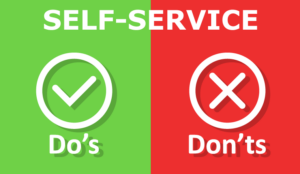Jennifer Passini, PhD at NICE, looks at setting yourself up for success with your digital self-service initiative.
I recently participated as a panelist in a webinar hosted by ICMI and HDI where we discussed the rapid expansion of digital omnichannel service options and the steps that organizations should take to set themselves up for success as they launch self-service initiatives. Here are some of the highlights.
The Rise of Digital Omnichannel
ICMI’s 2022 state of the Contact Center survey found that 66% of contact centre organizations classify themselves as omnichannel—an increase of 27% from the 2021 survey findings.
Further, during the webinar, it was noted that a significant majority of contact centres said that they now support digital self-service in addition to IVR (70% in the 2022 survey compared with 58% in the 2021 survey).
That’s because, across the industry, and across all types of consumers and demographics, it’s become clear that customers aren’t just open to a self-service option, they now expect it and prefer it, so any company or brand can suffer when that option is either not available or is ineffective at addressing the issue that they’re trying to solve.
What Customers Expect From Digital Self-Service
Universally, consumers want frictionless experiences. Though the priority and emphasis may differ slightly across demographics, there are four other critical features that all consumers are generally looking for from digital self-service:
- It should be easy to use
- It should be accurate
- It should help them take action
- It must be seamless on mobile
Today, self-service often tries to be all things to all people, but as noted in the webinar, it’s important to keep the preferences of various customer types in mind when building a self-service framework—especially if your customer base skews towards a particular demographic:
Baby Boomers:
Will use self-service if it’s not forced, if it’s simple. They don’t want a 50-page wiki to read through. They just want it to be easy.
Gen X’ers:
Having seen the rise of the information age all the way to the automation age, they just want it to be accurate: they want to get the info that they need and move on with their day.
Millennials:
They prioritize being able to take action. They appreciate getting great information through self-servicing, but they want to move with it—actually go forward and do something or architect something with the information.
Gen Z:
They are on their phones all day, so for them, it’s got to be seamless on mobile.
Committing to Self-Enablement in the Customer Journey
Easy, accurate experiences are table stakes. From a customer experience perspective, self-service is really about empowering self-enablement—customers choose specific channels because they want to do it on their own, to be self-enabled.
Whether it’s through online chat, SMS, social messaging, your mobile app or IVR, the customer expects to be able to have their needs met through a self-serve capability.
If your organization commits to self-service, think through your customer journey, and the orchestration of that journey, that leads to customers achieving what they want on their own.
Why Delivering an Easy Omnichannel Experience Isn’t Enough
Consumers are on a nonlinear journey, and even though they may initially prefer and choose self-service channels, they also want to be able to seamlessly engage with a contact centre agent, if they feel they need to.
For example, when using a chatbot, if something is not going well, consumers want the ability to be transferred seamlessly to a live agent so that they’re not wasting time—what’s more, they expect that all of the information they submitted to the chatbot will carry over.
That’s what omnichannel success looks like. It’s seamless, frictionless. So to meet consumers’ expectations, when developing self-enabled solutions, you need to think beyond just what’s going to be easy.
As noted in our webinar discussion, today’s consumers’ rallying cry is: “What do we want? Everything! When do we want it? Right now!”
The Benefits of Self-Service, From the Contact Centre’s Perspective
When talking with customer-facing organizations, contact centres sometimes express hesitance about self-service because they see it as taking away what they do and making it an automated experience. But the reality is that self-service delivers many benefits to the contact centre, including:
Operational Effectiveness:
When customers are self-enabled, contact centre agents are freed up to focus on the things that deliver high-value experiences for those questions and issues and problems that do come up.
Cost Management:
Obviously, self-serve channels enable customers to do things on their own, so in some cases, we’ve seen clients achieve cost savings of 50% or more, just by augmenting live agents with self-serve experiences and training agents to direct callers to self-service.
Better CX = Better CSAT, Loyalty, Revenue:
As we saw during the pandemic when call volume increased exponentially and organizations couldn’t handle it, it created negative experiences and negative brand perceptions.
So the shift to self-service, which reduces call volume, combined with agent focus on the most valuable experiences—rather than on inquiries that can easily be automated and become self-serve experiences, means that companies can deliver a better CX, which is reflected in better CSAT scores, increased loyalty, and revenue.
Again, customers expect to accomplish certain things on their own without speaking to an agent, so if your company isn’t meeting that expectation, those customers will move to brands that do, because they want to be more in control of what they experience and which channels they use.
Getting Started: How to Prioritize Self-Service Objectives
If your organization is getting ready to look for technology that will help you deliver effective self-service journeys, it’s important to think through and rank your top priorities and use cases, in the near-term and long-term.
A CX technology consulting organization can help you drill down and identify the right approach to address self-service strategies and customer experiences.
For example, while your top objective may be cost management, improving the customer experience can be an equal priority, because that will also improve your bottom line in the long term.
First, consider which use cases can help you accomplish both objectives, and then prioritize and rank them. There are many different ways to use modern tools available in a contact centre as a service platform.
Choosing Which Journeys to Automate
With your top objectives in place, the next step is to determine which actions and customer journeys to prioritize for self-service automation. This is where having good data and advanced analytics become key.
Use what you know to narrow your focus: what are you looking to accomplish over the next one to three years? Where are the pain points? Where are you hurting from a pure data metrics perspective, and, how can you address those with technology?
For example, I was working with a regional bank several years ago, pre-pandemic, and they found that 20% of the calls coming to their contact centre were about checking balances.
That made them pause and ask themselves, do we want our contact centre agents just checking balances for customers when that can easily be tackled through digital access or through an automated system?
When you start to look at call volume in terms of how much effort it’s taking not only to take those calls, but to resolve customers’ issues with very simple experiences and tasks, without adding CX value, those costs really start to add up.
How Self-Service Strategies Can Miss the Mark
We’ve looked at the benefits of self-service for both consumers and contact centre organizations, now let’s look at some of the pitfalls that can occur when companies jump into self-service initiatives underprepared.
Trying to Boil the Ocean:
Some organizations are so eager for the benefits of self-service that they try to do everything all at once. It’s important to identify the low-hanging fruit.
As mentioned above, use the data that you have to identify a priority use case that you can do very quickly and efficiently to deliver a fast time to value. Understand how you’ll measure it, and then get something in place to address it.
Lack of Data Discipline:
Accordingly, you need to have a solid data foundation in place in order to generate useful insights to drive your self-service initiative.
That means making sure that you’ve got the governance, the data warehouses, lake houses—all the structured and unstructured data that’s necessary to drive automation, and specially, the AI behind it.
Weak Knowledge Base:
To create an effective self-enabled journey, you need to empower consumers with a helpful knowledge base and FAQs.
It’s important to have complete, updated, accurate articles ready and accessible though the self-service technology you’re implementing. The better the information you provide early on, the more successful consumers will be.
Take a Customer-Centric Approach to Self-Enablement
The move to empowering customers with self-service accelerated during the pandemic, when exponentially higher call volumes and staffing challenges forced organizations to quickly analyze what types of calls truly required talking with a live agent, and which did not.
Today, that analysis continues as organizations evaluate how they will meet their customers’ increasing expectation of and preference for self-service.
Once your self-service initiative is up and running, you can continually improve CX by looking at which self-serve experiences are failing and leading to calls to the contact centre—where customers are starting in a preferred channel but landing somewhere that they don’t prefer.
This is a customer-centric approach to supporting self-service transformation because you are focused on those areas where you know that the customer wants to do it on their own.
And finally, while customers may prefer it, don’t move to a self-service route unless you can deliver on it or you’ll be doubly falling short of meeting customers’ expectations—which can have a significant negative impact your brand, loyalty, and revenue.
This blog post has been re-published by kind permission of NICE – View the Original Article
For more information about NICE - visit the NICE Website
Call Centre Helper is not responsible for the content of these guest blog posts. The opinions expressed in this article are those of the author, and do not necessarily reflect those of Call Centre Helper.
Author: NICE
Published On: 11th Apr 2023
Read more about - Guest Blogs, NICE






 NICE is a leading global enterprise software provider that enables organizations to improve customer experience and business results, ensure compliance and fight financial crime. Their mission is to help customers build and strengthen their reputation by uncovering customer insight, predicting human intent and taking the right action to improve their business.
NICE is a leading global enterprise software provider that enables organizations to improve customer experience and business results, ensure compliance and fight financial crime. Their mission is to help customers build and strengthen their reputation by uncovering customer insight, predicting human intent and taking the right action to improve their business. 











